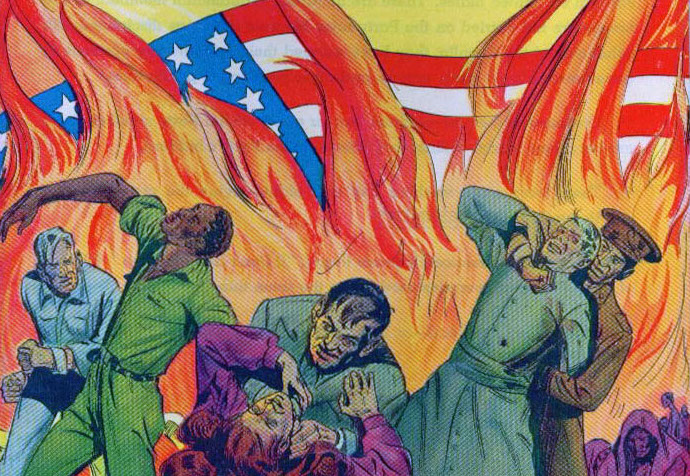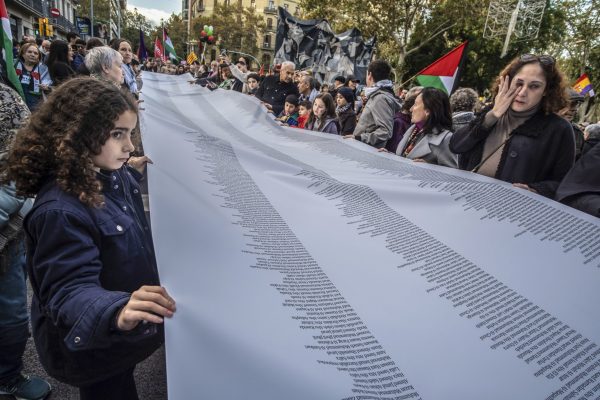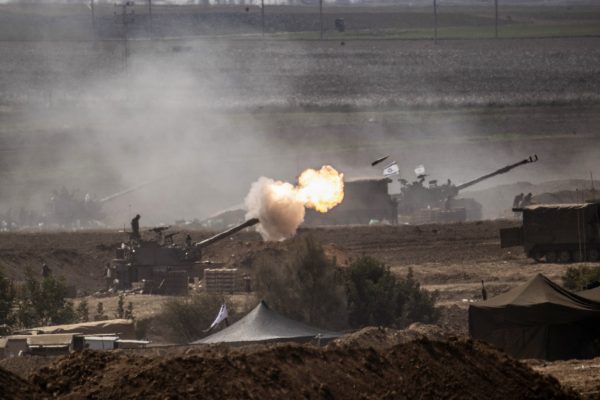This essay is featured in Boston Review’s Fall 2018 issue Evil Empire. Order your copy today!
Imagine an empire with a massive security sector, one barely accountable to the democratic will. This coercive system, though appearing self-perpetuating, represents an elite echelon’s efforts to protect and consolidate power. It employs so many people that its maintenance and funding is necessary, not because of the dictates of national security, but simply to keep all its workers from becoming “superfluous.” With a repressive apparatus notorious for its abuses, this security sector fosters the very domestic opposition it is designed to combat.
The idea that fundamental differences in approaches to incarceration drove the conflict between the United States and the Soviet Union strikes an odd chord from our current vantage point.
This outline, to some readers, may sound similar to the military-industrial complex—and its cognate prison-industrial complex—in the United States today. But this description actually comes from George Kennan’s foundational article “The Sources of Soviet Conduct,” which appeared in Foreign Affairs, under the byline X, in 1947. Kennan, perhaps more than anyone else, shaped the rhetoric of the Cold War in a way that made it seem preordained, inevitable. He is most often remembered for calling out the supposedly innate qualities of Russian culture—spiritual deprivation, cynicism, and conformity—upon which communist ideology had been grafted. This combination, he argued, was destined to conflict with the innate qualities of Americanism—its freedom of worship, its emphasis on individuality, and its support of business. But the dominance of the security sector was another persistent motif in Kennan’s work; he dedicated five paragraphs of “The Sources of Soviet Conduct” to the “organs of suppression.” Secret police lurked everywhere, the narrative went, and prisons were the Soviet Union’s primary feature. By 1953, under Joseph Stalin, 2.6 million people were locked up in the gulag and over 3 million more were forcibly resettled— a total of around 3 percent of the population kept under state control. Kennan’s point, like those of other foundational Cold War tracts, was clear: unlike the United States, the Soviet Union was brutally repressive.
The idea that fundamental differences in approaches to incarceration drove the conflict between the United States and the Soviet Union strikes an odd chord from our current vantage point. Today 2.3 million people are locked up in the United States, and an additional 4.5 million are on parole or probation, for a total of around 2 percent of the population under state control. While much has been written about how legal changes and racial politics led to the carceral state, it is also helpful to see how Cold War confrontation further contributed to the United States’ own gulag.
• • •
In the same year Kennan published as X, the National Security Act created the Department of Defense, the Central Intelligence Agency, and the National Security Council—the building blocks of the national security state. By 1950, in order to further counter the perceived Soviet threat, a top secret but widely known report argued that a blank check for the permanent war economy was needed to establish an offensive global posture. The report, “United States Objectives and Programs for National Security”—better known as NSC 68—planted the vocabulary that became the Cold War’s discursive kudzu. Though Kennan himself diverged from its predictions, NSC 68 echoed his formulations, contrasting the importance of U.S. “lawfulness” to Soviet expedience and absolutism.
NSC 68 drew much of its rhetorical power from carceral imagery. “The Soviet monolith,” it maintained, “is held together by the iron curtain around it and the iron bars within it, not by any force of natural cohesion.” The United States thus had to embark on a massive “build-up of political, economic, and military strength” to take advantage of the Kremlin’s “greatest vulnerability,” its relationship with the Soviet people. “That relationship,” NSC 68 charged, “is characterized by universal suspicion, fear, and denunciation.” At its core were “intricately devised mechanisms of coercion” from which the Kremlin’s power derived. The report went on to propose that the “artificial mechanisms of unity” of the Soviet police state would crumble if challenged from outside, which is what the cornucopia of U.S. national security spending would do. Though NSC 68 did not make specific recommendations regarding defense expenditures, the Truman administration almost tripled defense spending as a percentage of the gross domestic product between 1950 and 1953 (from 5 to 14.2 percent).
The widely shared images of repression in Soviet society became the preeminent security tools to protect the United States against Soviet expansionism.
The pathway toward the permanent war economy of NSC 68’s vision was not direct. It was contested in Congress and in public opinion. Critics rightly feared the emergence of a “garrison state,” a term that has been largely lost today. The necessary shifts entailed liberals accommodating conservatives. As historian Michael J. Hogan detailed, to find a way for fiscal conservatives to accede to the new appropriations that capital-intensive war-making would require in the atomic age, it was necessary for New Dealers to give up hope for continuously robust social-welfare appropriations. After the issuance of NSC 68, debate in Congress over appropriations taught conservatives to “decouple” the national security state “from the economic and social policies of the New Deal,” according to Hogan. New tax increases would cover the costs of coercion abroad but not of health, education, and welfare at home. The size of the budget for bombers and submarines would continue to increase, but the size of the social wage would not follow suit. New Dealers pushed “security” to the forefront of the national agenda in the first place by insisting that the government could protect citizens from unpredictable risks; now they were trapped in a cage of their own making.
The result was the military-industrial complex, as Dwight Eisenhower called it in his 1961 farewell speech. He wanted to highlight the entanglement of the military, arms manufacturers, and members of Congress, which he felt was imperiling democratic decision-making over the size of the military, its deployments, and its ever-increasing budget. Eisenhower also worried that a tradition of individual liberty would be difficult to reconcile with a national security state. But while his critique and terminology were indeed useful, Eisenhower was concerned only with the threat from abroad, failing entirely to see what the security state was already accomplishing at home.
From the 1940s through the 1960s, figures in the black freedom struggle—from W. E. B. Du Bois to Jack O’Dell—had been highlighting how the national security state’s coercions threatened not just individual freedoms but collective ones. As the United States increasingly accused its own citizens of being subversives, assuming them to be guided by a foreign power, the widely shared images of repression in Soviet society—prisons, exile, staged trials, and the “police apparatus”— became the preeminent security tools to protect the United States against Soviet expansionism. The United States imprisoned communists and black radicals such as Benjamin J. Davis after a series of highly publicized trials. Others, such as Claudia Jones, faced incarceration and then deportation. Reading NSC 68’s invocation of prisons and police as the kernel of the vulnerability of the Iron Curtain, then, it is impossible not to sense the paradox of U.S. global leadership. Emily Rosenberg has called it the “central dilemma” of NSC 68: “how to advocate ‘freedom’ by greatly enlarging the state’s capacity for coercion.”
• • •
The goal of the Kennedy administration’s Office of Public Safety was to make police in dozens of countries the preeminent tool in the fight against communist subversion.
The fear of Soviet expansion and the resulting political instability largely outweighed this philosophical question. One of Eisenhower’s own aides, for example, wanted him to emphasize the “worldwide tendency for orderly societies to break down into mob-ridden anarchies.” And it was this concern that became the overriding motivation of the Kennedy administration’s foreign policy. Not three weeks after Eisenhower’s farewell speech, Secretary of State Dean Rusk declared that a “mobile, substantial, and flexible U.S. capability for operations short of general war is essential.” Eisenhower adversary General Maxwell Taylor urged Kennedy to adopt this New Frontier policy, which, in practice, meant a focus on “counterinsurgency,” with police forces as the “first line of defense” against mob-ridden anarchies around the world, particularly those ginned up by subversives.
The Kennedy administration lodged its new police assistance program in the Agency for International Development, calling it the Office of Public Safety. The program, which was overseen directly by high-ranking National Security Council officials, consolidated and funded what had been a sprawling, poorly resourced, and inefficient set of operations to train, equip, and advise police in Africa, Asia, and Latin America. The goal was to make police in dozens of countries the preeminent tool in the fight against communist subversion. The Office of Public Safety’s advisors were experienced law enforcement experts, many of whom spent the immediate aftermath of World War II in the occupations in Germany, Italy, Korea, and Japan. After observing authoritarian police and prison systems firsthand, these experts developed a contrasting commitment to political independence of police and aimed to achieve it through more decentralized organizational reform, technical upgrading, and internal discipline. Their goal was to bolster and educate security forces in “developing countries,” and thanks to the constant stream of funding NSC 68 inaugurated, police trainees from other countries quickly learned about “police service under autocratic rule.”
But the effort to reject shadowy secret police—and the subversion model that U.S. national security experts feared the Soviets were exporting—was two-faced. The purpose of public safety assistance, advisors insisted, was to enhance democracy. And they aimed to foster respect for constituted authority among the citizenry by making the police efficient and technically adept. As the Office of Public Safety developed and implemented its curriculum, it bequeathed the most modern forms of U.S. policing to the world. Yet with no trace of irony, these lessons detailed how Soviet secret police sent advisors to “vassal” countries to “pull the strings” of the local security apparatus. Moreover, to ensure the mission stayed on course, a number of authoritarian German and Korean officers, especially those known for their exquisite anticommunism, became key U.S. assets in bolstering the security forces in other countries. It was as if the United States thought that to fight creeping authoritarianism, expert authoritarians had to be on hand.
It was as if the United States thought that to fight creeping authoritarianism, expert authoritarians had to be on hand.
Public safety officers, for example, consistently claimed to teach how not to torture suspects during interrogation. And they introduced new counterterrorism techniques. That meant, by Nixon’s presidency, showing trainees how improvised bombs were built—to demonstrate, they claimed, how to disarm them. But in both these examples, techniques of repression could easily be reverse-engineered. Many of these aid-recipient countries—from Uruguay to the Philippines—went on to practice harsh forms of policing while paramilitary death squads emerged in others, such as Guatemala. The U.S. image of Soviet repression was mirrored in U.S. client states.
• • •
To understand how these public safety advisors then advanced punitive modernization and the carceral state at home, we must return again to 1947. At the very moment the National Security Act took effect, another crucial document in the history of U.S. law enforcement emerged. The President’s Committee on Civil Rights had been investigating how law enforcement could safeguard civil rights, especially black civil rights, in the United States. The committee’s report to President Harry Truman, To Secure These Rights, advocated for what Mary Dudziak has labeled “cold war civil rights.” It was necessary to ameliorate racial inequality, this argument went, because the Soviet Union frequently invoked lynching and racial abuses to highlight U.S. hypocrisy.
Although the committee was unflinching in its assessment of how the fundamental civil right to the safety of one’s person had been violated frequently (Japanese, Mexicans, and African Americans, as well as members of minority religions, suffered the most), it also understood these problems of racial injustice to be the effect of white extrajudicial violence and “arbitrary” individual actions by cops, particularly in the South. Its solutions were thus focused on strengthening law enforcement and assuring its adherence to due process and administrative fairness. Similar to Kennan, the committee (and the generation of reformers it influenced) believed it was possible to use the tools of policing and prisons fairly, unlike in the Soviet Union.
Political scientist Naomi Murakawa has shown, however, that by framing the problem as arbitrary and as growing out of lawlessness, the committee effectively ruled out the systematic and legally enshrined character of racial abuse. What made it predictable, rather than arbitrary, was its consistent object: racially subjugated peoples. By diminishing the structural aspects of the abuse of minorities, liberal law enforcement reformers opened the door to a wider misunderstanding of what needed to be reformed. The response the committee endorsed—to enact procedural reforms and modernize law enforcement in the United States—rode the high tide of police professionalization initiatives that would crest in the following decades, and which called for a well-endowed, federally sanctioned anticrime apparatus. As historian Elizabeth Hinton and Murakawa have argued, this effort to reform law enforcement and codify its procedures actually made it more institutionally robust and less forgiving, contributing to the country’s march toward mass incarceration.
U.S. empire abroad found its replica in the War on Crime at home: to break the political syzygy of an authoritarian state apparatus in Sacramento or Saigon, police needed to be technically adept, flush with cash, and insulated from political machinations.
What is less understood, however, is the fundamental mismatch between what reformers and police chiefs imagined reform to look like. For liberal reformers, injustice looked like a lynch mob. For many police experts, steeped in Cold War ideology and trained in counterintelligence, it looked like the Soviet secret police. Mob rule had to be avoided, but so too did centralized authority over police objectives. Underlying reasons for what police did daily, and to whom, was not the concern of either party.
Command-level cops across the United States, after all, were quick to absorb the lessons and perspectives of public safety officers. In policing’s professional literatures, CIA officials published articles on topics such as policing in the Soviet Union, which emphasized the centralized governing hierarchy. The fact that Soviet police at the lowest level enacted the tyranny ordered at the top resonated with a generation of U.S. police reformers who had watched corrupt political machines in U.S. cities be dismantled. Police reformers thus demanded that police answer primarily to their own professional guidelines, free from political interference. In this way, the negative model of the authoritarian state was misleading: it may have prevented centralized dictatorial rule, but it left police power largely insulated. And so Cold War U.S. empire abroad found its replica in the War on Crime at home: to break the political syzygy of an authoritarian state apparatus in Sacramento or Saigon, in Wichita or Tokyo, police needed to be technically adept, flush with cash, and insulated from political machinations.
This cohered in the mid-1960s as rioting in U.S. cities and towns caught police underprepared, and officers beat and killed participants and bystanders alike. High-ranking officials in Washington, D.C., and many state capitals turned to the reform experts most familiar with riot control and street protest: public safety advisors. The 1968 anticrime bill thus followed a familiar Cold War model: it funded new federally coordinated riot-control training programs—training that mimicked what the Office of Public Safety urged overseas—and it authorized the purchase of huge supplies of tear gas as well as other technical instruments, from radios to helicopters to tanks.
A revised approach to riot control was but one result of the War on Crime. With a bureaucratic frame of mind that had its closest analog in the military-industrial complex, the “prison-industrial complex” was born out of its zeal for spending on the penal sector. Strategic planning of the best way to utilize those resources fell second. Moreover, by leaning so heavily on Cold War rationales, elected officials and law enforcement leaders started treating criminals as interchangeable with political subversives, thus eschewing rehabilitation efforts, as Micol Seigel has argued. If criminal propensity was similar to the dedication to a cause that marked political radicalism, rehabilitative efforts were pointless.
In 1969 two special investigations concluded that prisons were already ineffective at rehabilitation. New York researchers declared prisons to be hotbeds of radicalism, “more fertile breeding grounds for crime than the streets.” Federal research findings, endorsed by James V. Bennett, the retired Federal Bureau of Prisons director, were less caustic but corroborated fears of increasing crime due to the failings of prisons. Bennett was a lifelong reformer; earlier in his career, he had advocated for flexibility in sentencing, educational programs for prisoners, and other hallmarks of rehabilitation. But he and his staff also worked closely with the public safety program, advising prisons in Guatemala and Thailand, and he had spent a few years in occupied Germany learning how to dismantle an authoritarian system. Though Bennett continued to push for educational programs, the final recommendation of his investigation was to dedicate greater resources to incarceration, expand the number of guards, and upgrade the training they received.
The effort to reform law enforcement and codify its procedures actually made it more institutionally robust and less forgiving, contributing to the country’s march toward mass incarceration.
The War on Crime was a creature of federalism. Federal appropriations for upgrading police, courts, and prisons came embroidered with a commitment that no usurpation of local authority or discretion would result. Policing remained decentralized. Even when police killed unarmed people during unrest, causing public complaint, police were protected; outrage could be an orchestrated communist plot, the thinking went, intended to take control over law enforcement by undermining its autonomy. In this way, the reform effort preserved the petty despotism of the nightstick and localized tyranny of the police chief that was at the root of the racial crisis. By insulating police from federal oversight or control, while also affording them increased resources, particularly for capital-intensive repressive technologies, the War on Crime allowed the underlying structure of Jim Crow policing to persist.
• • •
In the end, U.S. police came to see extreme lawfulness—of which they were the sole arbiter—as the rejoinder to Soviet repressiveness, and a vastly inflated penal system as the bureaucratic shield against subversives on U.S. streets. Yet, seeing where it has gotten us—and what we have sacrificed in the process—it is hard not to compare our current system to “organs of suppression.” The prison-industrial complex of the present is marked by aggressive and technologically advanced policing, brutal conditions of incarceration, civic exclusion, and fiscal penalties that extends far beyond time served. It has metastasized despite crime declining in the same period. Just as key analysts of the impasse between the Eastern bloc and the United States found that repression seemed to persist for its own sake behind the Iron Curtain, Americans might question the purpose of the contemporary criminal justice system at home.
What made the early Cold War vision of Americanism distinct from that of totalitarianism was that the Soviet police answered directly to political leaders, whereas in the United States police had, by midcentury, mostly thrown off the shackles of the political machine that dictated their terms of employment. This independence remains important for democracy. But as crime continues to decline and appropriations for police continue to grow, the question of democratic control over the instruments of public safety becomes urgent, for public safety appears now to be the instrument for the control of democracy. Law enforcement leaders have become, as Kennan claimed they were in Russia, “masters of those whom they were designed to serve.”








